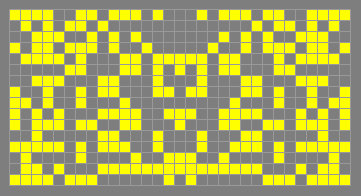A random initial pattern, either contained within a small area,
or alternatively filling the whole Life universe.
Finite soups probably have behaviors very different than infinite
soups, but this is obviously unknown. Infinite soups may remain
chaotic indefinitely since any reaction, no matter how rare, is bound
to happen somewhere.
Soups can have an average density, with results varying based on
that. See sparse Life for a discussion of what can happen at a low
density.
Finite soups for sizes such as 16×16 (asymmetric) have been
examined by the billions by scripts such as apgsearch to find
interesting results. Many new oscillators and synthesis
recipes have been discovered, as well as previously known rare
patterns such as stabilized switch engines. In addition, soups are
used to generate statistical census data, and to decide whether
specific objects can be considered natural.
Soups can be fully random, or they can be forced to be symmetric.
The results for these two types of soups can differ since symmetric
soups tend to create large symmetrical objects at a much higher rate.
Shown below is an unusual mirror-symmetric soup that produces a
pufferfish and nothing else.










